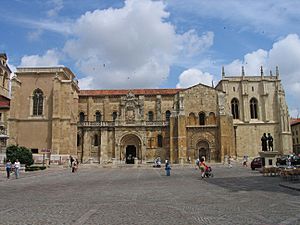Cortes Generales facts for kids
Quick facts for kids General CourtsCortes Generales |
|
|---|---|
| 15th Cortes Generales | |
| Type | |
| Type | |
| Houses | Senate Congress of Deputies |
| Leadership | |
|
President of the Senate
|
Pedro Manuel Rollán Ojeda (PP)
Since 17 August 2023 |
|
Francesca Lluc Armengol Socias (PSOE)
Since 17 August 2023 |
|
| Structure | |
| Seats | 615 265 senators 350 deputies |
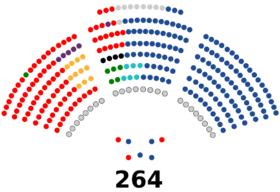 |
|
|
Senate political groups
|
Government (91)
Supported by (24)
Opposition (149)
|
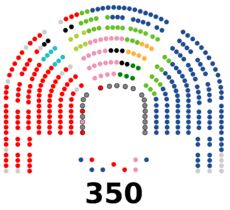 |
|
|
Congress of Deputies political groups
|
Government (146)
Supported by (33)
Opposition (171)
|
| Elections | |
|
Senate last election
|
23 July 2023 |
|
Congress of Deputies last election
|
23 July 2023 |
| Meeting place | |
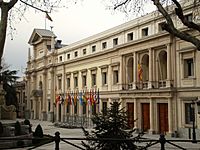 |
|
| Senate Palacio del Senado Plaza de la Marina Española Centro, Madrid |
|
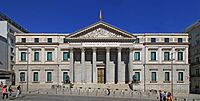 |
|
| Congress of Deputies Palacio de las Cortes Carrera de San Jerónimo Centro, Madrid |
|
The Cortes Generales (which means Spanish Parliament in English) are the main legislative body of Spain. Think of them as the country's big debate club and law-making factory! They have two main parts: the Congress of Deputies (often called the "lower house") and the Senate (the "upper house").
These two groups work together to create laws, check on the government, and make sure Spain is run fairly. The Congress of Deputies meets in the beautiful Palacio de las Cortes. The Senate meets in the Palacio del Senado. Both buildings are located in Madrid, the capital city.
People in Spain vote to choose most of the members of the Cortes Generales. This means that citizens have a direct say in who represents them. There are 615 members in total: 350 Deputies and 265 Senators. They usually serve for four-year terms. These representatives speak for all the people of Spain.
The Cortes Generales also has a very important job: it helps choose and can even remove the Prime Minister of Spain and their government. This shows how central the Cortes Generales are to Spain's democracy.
Contents
How the Cortes Generales Work Today
The modern Cortes Generales were created by the 1978 Constitution of Spain. This important document set up how Spain is governed today. It ensures that the people's representatives have a strong voice in the country's decisions.
The Congress of Deputies
The Congress is the "lower house" and has 350 members called deputies. These deputies are chosen directly by the people of Spain through voting. They represent different areas, mostly the provinces.
The Congress has a lot of power. It can approve or reject laws. It also has the final say in choosing the Prime Minister. If the Prime Minister loses the support of the Congress, they can be removed.
The Senate
The Senate is the "upper house" and has 265 members called senators. Most senators are also chosen by direct vote in each province. However, some senators are chosen by the regional governments of Spain's autonomous communities.
The Senate reviews laws passed by the Congress. It can suggest changes or even reject laws. But the Congress can usually override the Senate's decisions if enough deputies agree. People often discuss how to make the Senate better represent Spain's different regions.
A Look Back: The History of Spain's Parliament
The idea of a group of people advising a ruler or making laws is very old in Spain. It has changed a lot over many centuries.
Early Councils and Kingdoms
Long, long ago, during the time of the Visigothic Kingdom, there were councils. These groups helped kings make decisions and laws. They were mostly made up of powerful leaders and church officials.
Later, in the Middle Ages, different kingdoms in Spain had their own "royal councils." These councils were called cortes in Spanish. They started with nobles and lords close to the king.
The Rise of Cities in Parliament
A very important moment happened in 1188 in the Kingdom of León. King Alfonso IX called a meeting of the Cortes. For the first time, regular citizens from the cities were invited to join the nobles and clergy. This was a big step towards modern parliaments.
As trade grew, cities became more important. Kings would often ask the Cortes for money for wars or other needs. In return, cities would gain special rights and freedoms. This gave the people in cities more influence.
Changes Under Different Rulers
When Spain united under powerful kings and queens like Isabella and Ferdinand, the monarchs gained more power. The Cortes' influence sometimes decreased. For example, in the 1500s, after a revolt by citizens was strongly put down, the Cortes became more of an advisory group.
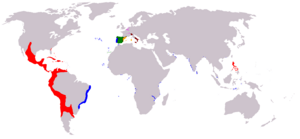
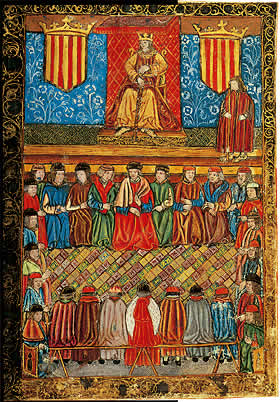
However, during the 1600s, when the kings faced financial problems, the Cortes sometimes regained some of their old power. They helped manage the country's money and advised the king.
New Ideas and Republics
In the early 1700s, after a war, the new Bourbon kings changed things. They reduced the power of many regional Cortes. Spain became more centralized, with less local autonomy.
A very important Cortes met in Cádiz in 1810, during a time of war. This "Cortes of Cádiz" created Spain's first modern constitution in 1812. It was a very liberal document, giving more power to the people. However, when King Ferdinand VII returned, he tried to undo these changes. This led to many disagreements and periods of political change.
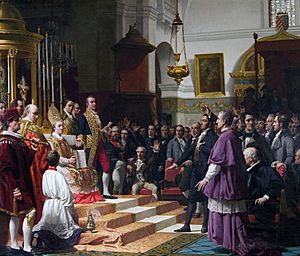
Later, in 1873, Spain briefly became a republic. The Senate was removed because its members were chosen by the king. But this First Republic did not last long, and the monarchy was soon restored.
During the period known as the Restoration (1874-1930), Spain had a king and a parliament. There was a system where two main political parties would take turns governing. However, there were often accusations of unfair elections. This led to growing political tension and eventually a period of dictatorship.
In 1931, Spain became a republic again, the Second Spanish Republic. A new constitution was written. It gave women the right to vote for the first time! The parliament was unicameral, meaning it had only one house. However, there were very strong political disagreements between different groups in Spain. These intense arguments eventually led to a major conflict in 1936, which ended the Second Republic.
A Time Without Democracy
After the conflict, Francisco Franco ruled Spain for many years (1939-1975). During this time, a body called the Cortes Españolas was created in 1942. However, its members were not elected by the people. This Cortes had no real power. It was mainly a symbolic assembly, and Franco made all the important decisions himself. This was not a democratic parliament.
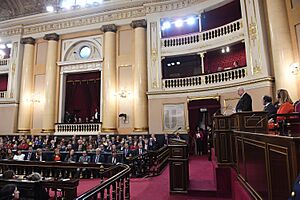

See also
 In Spanish: Cortes Generales para niños
In Spanish: Cortes Generales para niños
- List of presidents of the Congress of Deputies of Spain
- Solemn Opening of the Parliament of Spain
- Bureaus of the Cortes Generales
- Spanish Parliamentarism


